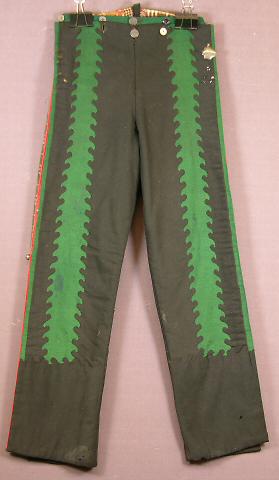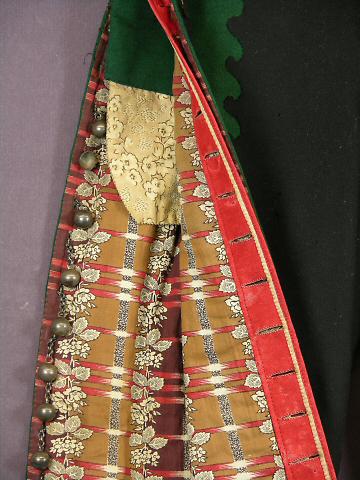2009.17.1
(38.73 cm WIDE)
This pair of calzoneras is made of black and green fulled wool. The black wool, which composes the inner leg, the outer leg and the cuff is appliqued over the green fulled wool which forms the center of each leg, and runs up to the waist. (Also shows at center waist, back where the trousers appear to have been let out at some time.) The pattern at the intersection of the two colors is a rolling scallop pattern (like a simplified drawing of ocean waves. The legs are completely open down the outside; the are fastened with a series of twenty-six (26) hand made button holes (in a strim of red fulled wool sewn over the lining on the outside of each leg; a very narrow stip of white cloth is appliqued the length of each leg, abutting the button holes. There are a series of twenty-two (22) silver colored metal ball and chain buttons down either leg. The buttons are ball shaped on the part that would fasten through to the front and flat on the back side. The calzoneras are completely lined in a tan, brown and madder colored cotton print that features white (undyed) flowers and leaves in vertical lines and a stripe of a seaweed type print also printed vertically separating the vertical bands of tan and brown, with horizontal bars of white and madder color in groupings of three and of one. There's a pocket on either side made of a tan and natural colored cotton floral print. These are "broad fall" trousers fastening with three buttons (horizontally) across the front, and three buttons inside the fall, fastening vertically in the printed lining fabric. There is a set of scalloped, seashell-like silver colored metal hook fastener on the proper left side approximately 2.5 inches down from the waist. On the proper right side, only the part of the set in the back is still in place. There is a flat button at the proper right waist. There are two flat buttons approximately even spaced from the center seam in the back.
These are hand tailored. The red strip down either leg is indicative of their fine quality. According to David W. Rickman, "Sutter's Fort State Historic Park, Costume Manual: A Guide to the Clothing Worn in California and the Far West, ca. 1845," "...an added flap of cloth inside the front leg to button into."
Used: horseback riding | Ranching | Californio









